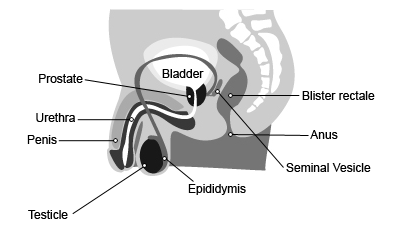Benign prostatic hyperplasia
The prostate is a small gland located under the bladder and in front of the rectum. It secretes certain components of sperm. It reaches full size in adulthood. However, it begins to grow again in most men as they age.
Causes and triggers
Benign prostatic hyperplasia is a natural consequence of aging. Benign means that it is not caused by cancer. It does not increase the risk of getting cancer either.
The causes of benign prostatic hyperplasia are not well known. It is likely related to hormonal changes, including changes in testosterone. Certain factors may also contribute to the occurrence of this condition, including the following:
- Aging
- Family history of benign prostatic hyperplasia
- Excess abdominal fat
- Lack of physical activity
Certain prescription and non-prescription medications or products can also exacerbate symptoms. Consult your health care provider for information on which ones to avoid.
Symptoms
The prostate is usually the size of a walnut. In cases of hyperplasia, it can grow to the size of a tennis ball. As it grows, the prostate compresses the urethra and reduces the amount of space available for urine to pass through.
Below are the main symptoms of an enlarged prostate:

- Difficulty starting or stopping urination
- A weakening of the urine stream
- A decrease in the amount of urine passed
- A feeling that the bladder has not emptied fully
- The urge to urinate more frequently, especially at night
- The urgent need to urinate
- Pain or burning with urination
- Difficult or painful ejaculation
- Blood in the urine or semen
Certain complications can occur if severe symptoms are not treated, including the following:
- Urinary tract infections
- Bladder stones (mineral deposits in the urine)
- Incontinence
- Inability to empty the bladder
- Renal impairment
Please note that other health conditions can cause these symptoms, such as an infection, prostate cancer, or an overactive bladder. If you are experiencing these symptoms, please consult your health care provider.
Treatment
Benign prostatic hyperplasia is treated in cases of significant discomfort or complications. Changing certain lifestyle habits can make a real difference. Determining which ones help can be done through careful observation. Here are a few examples:
- Reduce your fluid intake, especially in the evening
- Avoid certain foods (e.g., alcohol, coffee, tea, soft drinks, spicy foods)
- Rehabilitate your bladder with pelvic floor exercises
- Avoid constipation
Otherwise, symptoms are generally treated with prescription medications. It may be necessary in some cases to undergo surgery.
When should I see a health care professional?
Speak with your health care provider in the following cases:
- You have difficulty starting or stopping urination
- You notice that the strength of your urine stream or the amount of urine you pass is decreasing
- You still have the urge to go after urinating
- You have the urge to urinate more frequently
- You feel an urgent need to urinate
- You feel pain or a burning sensation when you urinate
- You have difficulty ejaculating or experience pain with ejaculation
- You see blood in your urine or semen
For more information:
© Copyright Vigilance Santé
The patient information leaflets are provided by Vigilance Santé Inc. This content is for information purposes only and does not in any manner whatsoever replace the opinion or advice of your health care professional. Always consult a health care professional before making a decision about your medication or treatment.
